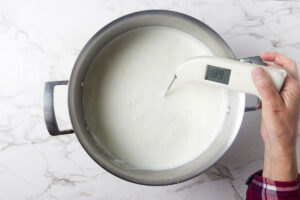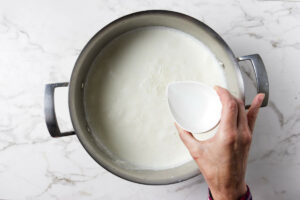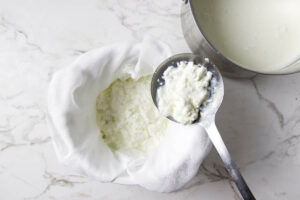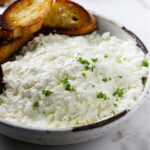Homemade Fresh Ricotta Cheese
This homemade ricotta cheese is creamy, fresh, and far better than anything from the store. Made with just milk, acid, and salt, plus a slow, gentle heating method for better texture and flavor. It’s perfect for lasagna, toast, pasta, or desserts. You will get 2 to 2½ cups of ricotta from this recipe.
Servings: 6 servings
Ingredients
- 8 cups whole milk not ultra-pasteurized
- ¼ cup heavy cream optional, for a richer texture
- 1 teaspoon salt
- 3 to 4 tablespoons distilled white vinegar or lemon juice
Instructions
- In a large pot, combine the milk, cream (if using), and salt. Set over medium-low heat and slowly warm to between 185°F and 190°F, stirring occasionally to avoid scorching.

- Once the milk reaches temperature, gently stir in the vinegar or lemon juice. Curds should start forming right away. Start with the smaller amount, and add more only if curds don’t form.

- Lower the heat as needed to maintain a temp between 175 to 185°F and hold it there for 20 minutes. Don’t stir, just let the curds set and develop flavor.

- Use a slotted spoon to gently lift the curds into a cheesecloth-lined sieve set over a bowl (you can use a thin dish towel if you don’t have cheesecloth). Let the ricotta drain for 10 to 30 minutes, depending on your preferred texture (shorter for creamy, longer for drier ricotta).

- If desired, stir in a pinch more salt or a splash of cream after draining for extra richness.
Notes
Use a heavy-bottomed pot as it distributes heat more evenly and prevents hot spots.
Heat slowly: Use medium-low to low heat. It takes a little longer, but slow heating helps avoid scorching.
Don't skip the 20-minute hold. Keeping the heat between 175 to 185°F for 20 minutes deepens the flavor and gives you fluffier, more ricotta-like curds. It also helps boost the yield slightly.
Scoop the curds with a slotted spoon instead of dumping everything through the strainer. Fine mesh gets clogged fast and slows down draining.
Milk choices: Don’t use ultra-pasteurized milk, it won’t curdle properly.
Cream: Optional but adds a richer flavor. You can use ultra-pasteurized cream in small amounts, as long as the milk itself is not ultra-pasteurized.
Acid options: White vinegar gives a clean flavor, lemon juice adds a subtle citrus note.
Texture control: Shorter drain time = creamy ricotta. Longer drain time = firmer, crumbly ricotta. Let it drain longer if you plan to use the ricotta in baking recipes.
Use right away or transfer to an airtight container and refrigerate for up to 5 days.
Uses: Stuffed shells, lasagna, toast, pasta, desserts, basically anywhere you’d use store-bought ricotta.
Yield: This recipe makes about 2 to 2 ½ cups of ricotta, though the amount can vary based on the milk, how much acid you use, and the temperature. Keeping the mixture between 175–185°F helps the curds set gently and gives the best yield.
Nutrition count is based on ⅓ cup ricotta cheese.
Nutrition
Serving: 1 serving | Calories: 92kcal | Carbohydrates: 6g | Protein: 4.4g | Fat: 5.6g | Saturated Fat: 3.2g | Cholesterol: 20mg | Sodium: 205mg | Potassium: 199mg | Sugar: 6.4g
